Mastering the Art of the Kitchen Sink
Designing for diversity, functionality, and multiple generations
![]() Continuing Education
Continuing Education
Use the following learning objectives to focus your study while reading this month’s Continuing Education article.
Learning Objectives - After reading this article, you will be able to:
- Identify what materials are available for sinks today and discuss the comparative aesthetic, strength, and durability attributes of these materials.
- Describe how to specify an easy-to maintain, hygienic sink and its details that meet the design scheme and user group needs.
- Explain how to specify a sink that meets ADA and what design requirements to be aware of under ADA compliance.
- Recognize new trends in kitchen sinks and how these can be best utilized for your clients and design plan.
“The more you know, the more you can create. There’s no end to imagination in the kitchen.” —Julia Child
The kitchen is heralded as the heart of the home, and, in this role, it is the center for family, food, and entertainment. It is also the hardest working room in the home—required to be stylish, aesthetically pleasing, functional, durable, and hygienic.

All images courtesy of BLANCO
Today’s kitchens face additional demands from diverse user groups. Kitchens may be placed in a universal design, requiring accommodation of users aged infant through to the elderly; serving multiple duties in a tiny home; or simply trying to keep up with a young and growing family. As home designs increasingly remove walls in favor of open plans, kitchens are integrating fully with living space, transforming them into living kitchens.
At the center of this busy kitchen space is the sink. Since a significant part of the work in a kitchen happens at the sink, having one that is easy to use and properly designed is extremely important. To have a beautiful, usable kitchen sink, there are several design parameters helpful in guiding sink selection. First among these is to ask how the kitchen is going to be used. That is followed by consideration of how the various flows and different work areas are going to be integrated throughout the kitchen. Finally, the designer and architect must address the question of who will be using the kitchen. Asking about “who” means thinking about “how”—how can the kitchen best enable productivity, safety, and the welfare of its users?
“As far as specifying sinks, there are a few things we look for,” says Alex Duran, project architect, Godden Sudik Architects. “These are material, configuration, and setting.” The sink is the most important workplace in the kitchen. Sixty percent of time spent in the kitchen is spent at the sink. Sinks allow for food preparation, washing, and cutting, and the best sink design should make these tasks as efficient as possible.
Paying attention to the unique combination of client needs and required functionality will guide the selection of the best size, material, and style of kitchen sink.
The Materials of the Art
When selecting a kitchen sink, its attributes will impact its ergonomics and functionality. First and foremost, a sink’s material dictates its cost, functionality, and lifespan. Secondarily, a sink’s material helps to support and enhance a kitchen’s design and aesthetic.
Regardless of material, there are several key parameters that designate a quality sink. The best kitchen sink design will have an equal measurement at the top and bottom to make the most of every inch. Sinks with smaller bottom measurements reduce usable space. The design should direct water straight toward the drain. Quality sinks are crafted with smooth, easy-to-clean corners, either perfectly square or slightly rounded, with no weld lines to ease cleaning and keep the bowl hygienic. All finishes must be even since uneven finishes invite bacterial growth in flaws. While aesthetics are typically linked first to material, the sink’s material has a major effect on how healthy and usable the sink will be. Different materials require different maintenance strategies and can create hygienic benefits.
Stainless Steel
The most popular material for kitchen sinks today remains stainless steel. Because of its flexibility as a material, stainless steel sinks are available in a wide variety of sizes, styles, and types. Stainless steel is heat, stain, and chip resistant.
Stainless steel is classified in terms of gauge. A lower gauge number means slightly thicker steel was used in the sink’s construction, while a higher gauge number means thinner steel was used. Most sinks fall within the 16- to 24-gauge range, with the majority of residential sinks falling between 18 and 22 gauge. However it is important to note that the actual difference between gauges is small. For example, the difference in thickness between a 16-gauge and 18-gauge sink is only 1/16 inch.
To add an extra aesthetic to the stainless steel, manufacturers may offer different finishes, from satin to glossy.
A superior stainless steel sink is made of 304 series alloy stainless steel, featuring the highest-quality 18/10 chrome-nickel formulation. This nonporous material provides a hygienic, rust-free, and extremely durable product. Certain manufacturer finishes, such as a satin polished finish, help to create an enduring, easy-to-clean luster that is impervious to water stains and calcium deposits.
Stainless steel sinks do have several drawbacks. As a material, stainless steel easily conveys noise, so sound-deadening pads or a spray coating should be incorporated to reduce sink noise from running water and the garbage disposal. Stainless steel can also scratch more easily than other sink materials and is liable to show water spots. Cheap stainless steel sinks with uneven finishes can quickly discolor and may allow bacteria to grow in finish flaws.
While prices are dependent on the gauge of the steel, its size, and its mounting type, stainless steel offers an affordable and durable material choice for the kitchen sink.
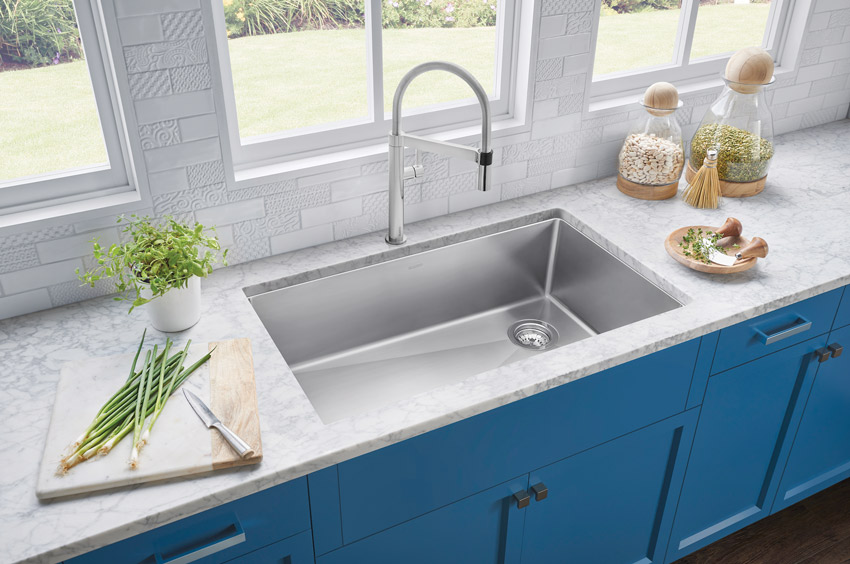
Stainless steel sinks remain the most popular material choice for kitchens today. Certain manufacturer finishes, such as a satin polished finish, help to create an enduring, easy-to-clean luster that is impervious to water stains and calcium deposits.
Cast Iron
One of the oldest materials used for sinks, cast iron remains a popular design choice. To manufacture the sink, a glossy porcelain enamel finish is fused over a cast iron base. Because the outer finish is an enamel, cast iron sinks come in a range of colors that offer good resistance to fading. The durable, glossy enamel also resists stains and scratching.
Cast iron sinks do have several drawbacks; principle among these are their weight. Cast iron sinks can easily weight in at more than 100 pounds, up to three times more than a stainless steel sink, meaning difficulty in installation and the requirement of additional supports for certain installation methods. The weight of cast iron also impacts cabinet choices; selected cabinets must be structurally sound to provide adequate support for the sink over time. Additionally, if the sink’s enamel coating does chip, the cast iron beneath is highly susceptible to rust, necessitating repair.
Cast iron also is more expensive than stainless steel, with designer color selections carrying a premium price tag.
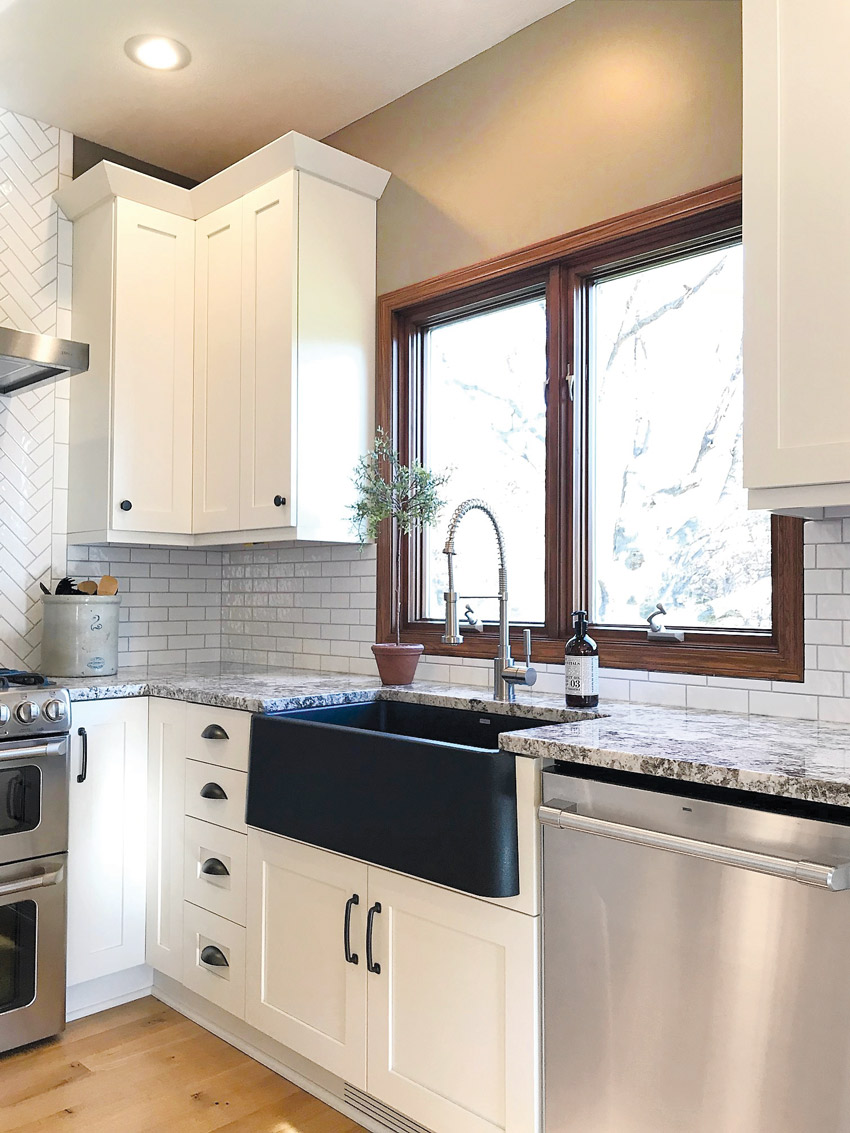
Farmhouse-style sinks lend a rustic aesthetic and are a popular trend for kitchen design.
Composite Sinks
An emerging sink material over the past decade, composite sinks are usually made from either a granite or quartz composite. The crushed stone is mixed with a resin filler, in an average ratio of 80 percent stone to 20 percent resin. This combination produces a material that shares aesthetic qualities with real granite or quartz without the maintenance and durability issues associated with solid stone sinks. It also allows for a range of color options, depending on the manufacturer. The variable color palette gives it the ability to pair well with a variety of natural stone and granite countertops.
Composite sinks are tough and highly resistant to stains and scratching, but, as a general rule, granite composites have a higher durability than quartz. The leading granite composite sinks also boast heat resistance up to 536 degrees Fahrenheit, exceptional cleanability with hydrophobic finishes, and resistance to household acids and alkali solutions.
Entry-level composite sinks have a price point comparable to cast iron and can increase in price from there, depending on composite material and color.
Fireclay
Fireclay sinks are manufactured by molding ceramic clay into the desired shape, allowing the clay to dry, and then applying porcelain enamel at extremely high temperatures. This process effectively fuses enamel to the clay, helping to enhance the sink’s strength. Because the clay base determines the shape, fireclay sinks are available in a wide variety of sizes and shapes and can suit any installation method. Fireclay sinks are highly resistant to scratches, staining, and chipping and are easy to clean. Fireclay sinks are most commonly associated with farmhouse or apron-style sinks. Both the shape and material bring a rustic countryside aesthetic to any classic or contemporary kitchen design.
However, fireclay can be more prone to chipping than other sink materials, requiring proper installation and care to minimize this risk. The enamel coating can also chip under impact from dropped pots and pans.
Fireclay kitchen sinks do command a price premium, and tend to be one of the more expensive material options.
Copper
As a material, copper offers durability as well as being naturally rust resistant and antimicrobial. The copper surface may be hammered for a rustic aesthetic, and the material develops a patina as it ages.
Careful selection is a must when considering a copper sink. A quality copper sink is at least 99 percent pure copper. A small amount of zinc, added for strength, is allowable. The sink should also be properly sealed by the manufacturer and maintained according to manufacturer instructions. No harsh chemicals may be used on copper, as it will destroy the finish.
Copper sinks command a price premium, making them one of the more expensive sink materials.
Alternative Materials
- Natural Stone: Designers are experimenting with natural stone sinks to match or complement natural stone countertops in kitchens. While some materials, like soapstone, resist stains well, many natural stone sinks easily stain and will need proper maintenance and sealing to remain hygienic.
- Glass: Tempered or safety glass offers a strong and striking sink material, particularly for contemporary design. However, contact with heavy objects can cause scratches or chips, and the glass surface clearly shows water and soap spots.
- Fiberglass: Fiberglass-reinforced plastic can be molded into a variety of shapes and sizes, and is inexpensive, strong, and lightweight. However, these sinks have a short lifespan, are not as durable, and do not maintain their surface finish as well as other materials.
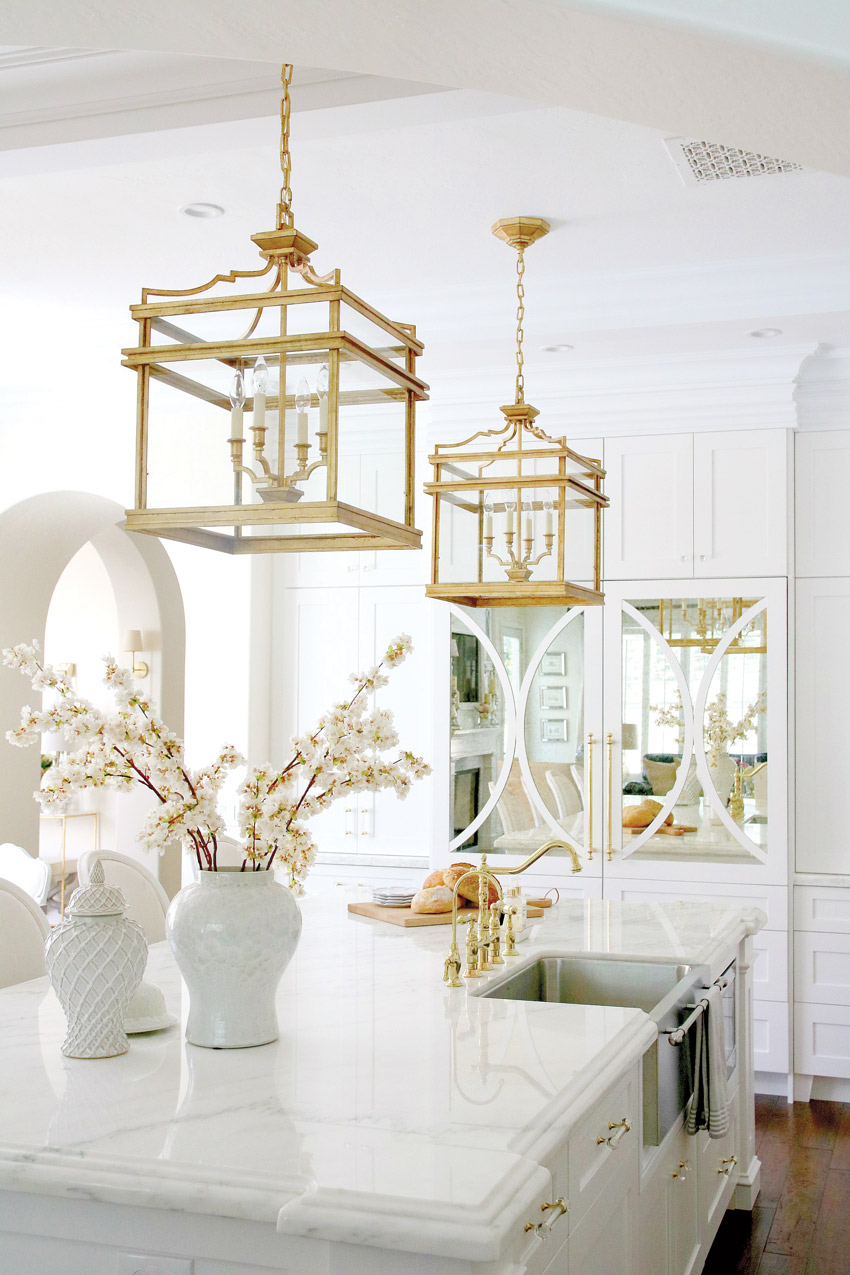
The kitchen sink at the Garrett Residence reflects the overall aesthetic of the home, marrying modern materials with rustic design.
The Details of the Art
Sensible space utilization, ergonomic design, and ease of cleaning are watchwords for both general kitchen design and kitchen sink specification. Although residential codes govern outlet placement, list mechanical requirements for exhaust, and, in certain locations, may even dictate plumbing standards, no official codes outside of the Americans with Disabilities Act (ADA) currently apply to kitchen sinks or kitchen design. The designer and architect are free to develop their own principles and approaches to defining best design and to support health, safety, and welfare.
When setting goals for a prospective sink, it helps to frame those details within overall goals for kitchen design.
There are five general areas in a kitchen:
- Pantry area: food storage space, canned goods, refrigerator
- Storage area: appliances, utensils, cookware
- Sink area: cleaning
- Preparation area: counter space
- Cooking area: stove and oven
The pantry, sink, preparation, and cooking areas are permanently melded in pursuit of preparing a meal in the most efficient way possible. Ideally, the arrangement of the sink, preparation, and cooking areas produce a narrow, triangular work area.
Ergonomics and functionality, therefore, become key virtues for any kitchen and any kitchen sink.
The Occupational Safety and Health Administration (OSHA) defines ergonomics as fitting a job to a person. This fit helps lessen muscle fatigue, increases productivity, and reduces the number and severity of work-related musculoskeletal disorders. These same principles are at work in a residential design. Thinking about potential user groups and adapting design usability means crafting a best fit and selecting a sink to improve productivity and alleviate potential stressors and irritants during the course of everyday use. The size, depth, drain location, ease of maintenance, and mounting type of a sink all impact its potential “fit” profile. These considerations then develop a project’s sink specifications.
Sink Size
A sink is one of the hardest-working fixtures in the kitchen, and the bottom of the sink is the surface where the homeowner takes care of most of the work, like cleaning and prepping. Maximizing the size of any sink at its base is critical to its functionality. Verifying that a sink has the same width at both top and bottom means exploiting every inch of the sink’s utility, especially at the base.
Today, single-basin sinks are available in a full range of sizes, from super to compact. Compact single basins are ideal for situations where overall space is at a premium or where user-specific design calls for multiple sinks. Across the board, single-basin sinks are the fastest-growing sink type. The basin of a single-bowl sink will offer more usable space than that of a double-bowl sink designed to fit into the same opening. A larger basin makes cleaning large dishes and pans much easier.
Double-bowl sinks—once the standard in kitchen design—do offer flexibility to the user, effectively creating two workstations. The best double-basin designs should still be able to comfortably accommodate large dishes and pans to maintain their functionality.
Sink Depth
Ergonomics and sink depth are vitally linked. As most work takes place at the base of a sink basin, that basin should never be so deep as to force the user to bend over, placing stress on his or her back, shoulders, and arms. The ideal sink depth should be based on the individual needs and physicality the client.
While there is no perfect formula for identifying an ideal sink depth, sinks are typically mounted 36 inches from the floor and can span anywhere from 6 to 12 inches in depth, with the majority of modern sinks ranging between 8 to 10 inches. Specific calculations may be made in correlation to a user’s height. “A shallow 6- to 8-inch bowl will be most comfortable for those who are either fairly short (5 foot 4 inches inches or shorter) or very tall (6 feet or taller). This will allow both types of figures to work at the bottom of the sink without having to crouch or hunch over. Individuals between the 5-foot-4 to 6-foot range will find most comfort in the 8- to 10-inch-deep basins.”
Designers and architects need to consider not only the sink’s basin depth but also the planned method of installation. For undermount sinks, the countertop may add up to 2 inches to the final sink basin depth.
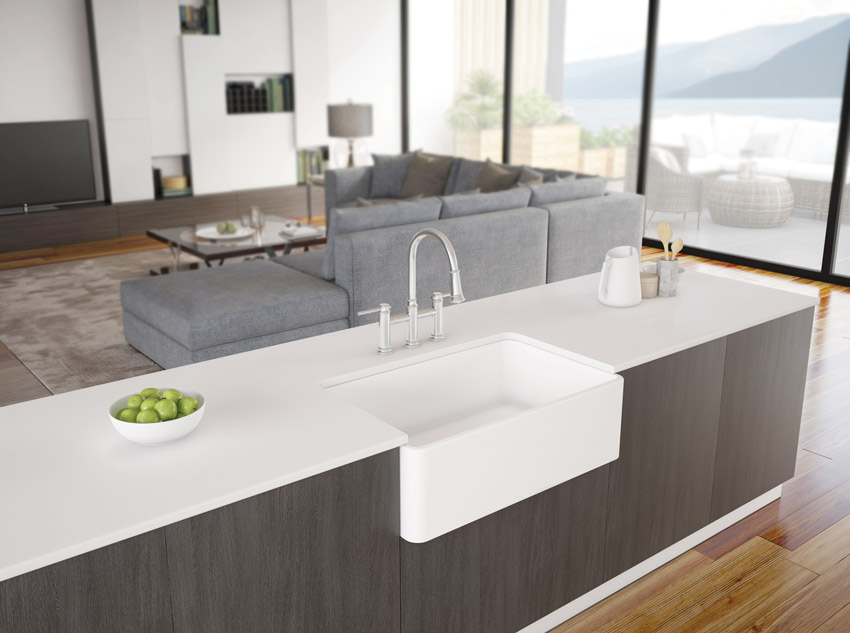
A sink’s depth, size, drain location, and ease of maintenance play crucial roles in its functionality.
Drain Location
Sinks today not only feature center or center-rear drains but also offer rear corner or offset drains. To determine the best location for a drain, the main functions of the sink and the preferences of the client should be considered. Avid home chefs stacking multiple large dishes in a single-basin sink may become frustrated over a blocked central drain and prefer an offset drain located to the side. Regardless of drain’s location, the basin should provide for an uninterrupted path for draining and should not allow for pooling of water.
Ease of Maintenance
The kitchen sink is the revolving door for heavy objects, food, and potential bacteria, meaning the best sink must be durable and easy to clean. Sinks with rough, uneven, or brushed finishes can become a breeding ground for bacteria. A rough finish introduces food and food protein into the grooves and crevasses, providing a perfect environment for bacteria to grow.
These bacteria can form a biofilm, making it extremely difficult for bleach and other cleaning products to actively wash it away. A smooth and even finish is easier to maintain.
Kitchen sinks crafted with smooth corners that are either precisely square or perfectly curved allow for an easy and quick clean, eliminating dirt buildup and the potential for bacteria to grow. Running a finger along the corner of a sink’s basin should reveal whether it is smooth and seamless or disclose any welds or faults in the design.
For clients with an extra concern about cleanliness or ease of maintenance, maintaining a single-bowl kitchen sink is typically slightly faster and easier due to reduced corners and edges.
Mounting Type
Sinks may be installed or mounted to surrounding surfaces using several different methods. While mounting type is often driven by aesthetics, the ease of maintenance, functionality, and sink type should also be considered. Before specifying a sink, it is essential to consider how the sink will be integrated into the overall design and what other materials will be used to complement its installation.
Inset Sinks
Inset sink mounting uses the most conventional method of installation. The sink basin is simply inserted from above into a prepared cutout in the countertop. Also referred to as top-mount or drop-in installation, this method makes a sink relatively easy and inexpensive to install. The lip of the sink reduces the need for an internal support system under the counter for most sink materials, making this type of sink a good choice for do-it-yourselfers or people on a budget.
The interface of the sink lip and counter can accumulate dirt and harbor the potential for bacterial growth. Stylistically, top-mount methods also may be a poor fit in contemporary kitchen designs, as they lack the sleek, modern appearance of other installation approaches. Some manufacturers can offer a flush-fit look on sinks to modernize inset installations.
Flush-Mount Sinks
With this attractive installation method, the sink and the worktop form a continuous unit that is perfectly level and has no joints. Keeping flush-mount sinks clean and hygienic is easy: water, crumbs, and other scraps can be wiped straight into the bowl because there is no obstructive edge at the rim of the sink. No cracks or seams exist to trap waste and create a breeding ground for bacteria. A flush-mount sink allows for more work space because the seamless transition between work surface and sink creates a continuous surface. This mounting method also is aesthetically pleasing, avoiding the eye-line interruptions of an inset sink.
Flush-mount sinks are a more complicated installation than inset and do require careful measurement and planning.
Undermount Sinks
An undermount sink is mounted underneath the counter surface. Like a flush mount, there is no lip or rim, so that the edge of the counter drops off directly into the sink basin. Undermount sinks also share many of the positive attributes of flush mounting: easier maintenance, functional extension and better integration of the available worktop, and a harmonious overall impression.
However, undermount kitchen sinks do have some distinct disadvantages over inset sinks. One of the biggest drawbacks is cost. Undermount models require more work to install. To be properly secured, the sink basin must be glued to the underside of the counter. Heavier sink materials, like fireclay or cast iron, will need an additional internal support system. Planning and layout also become crucial, as most undermount sinks are not designed with space for faucets and attachments. Additional holes, cut into the counter top, will be required to install these components.
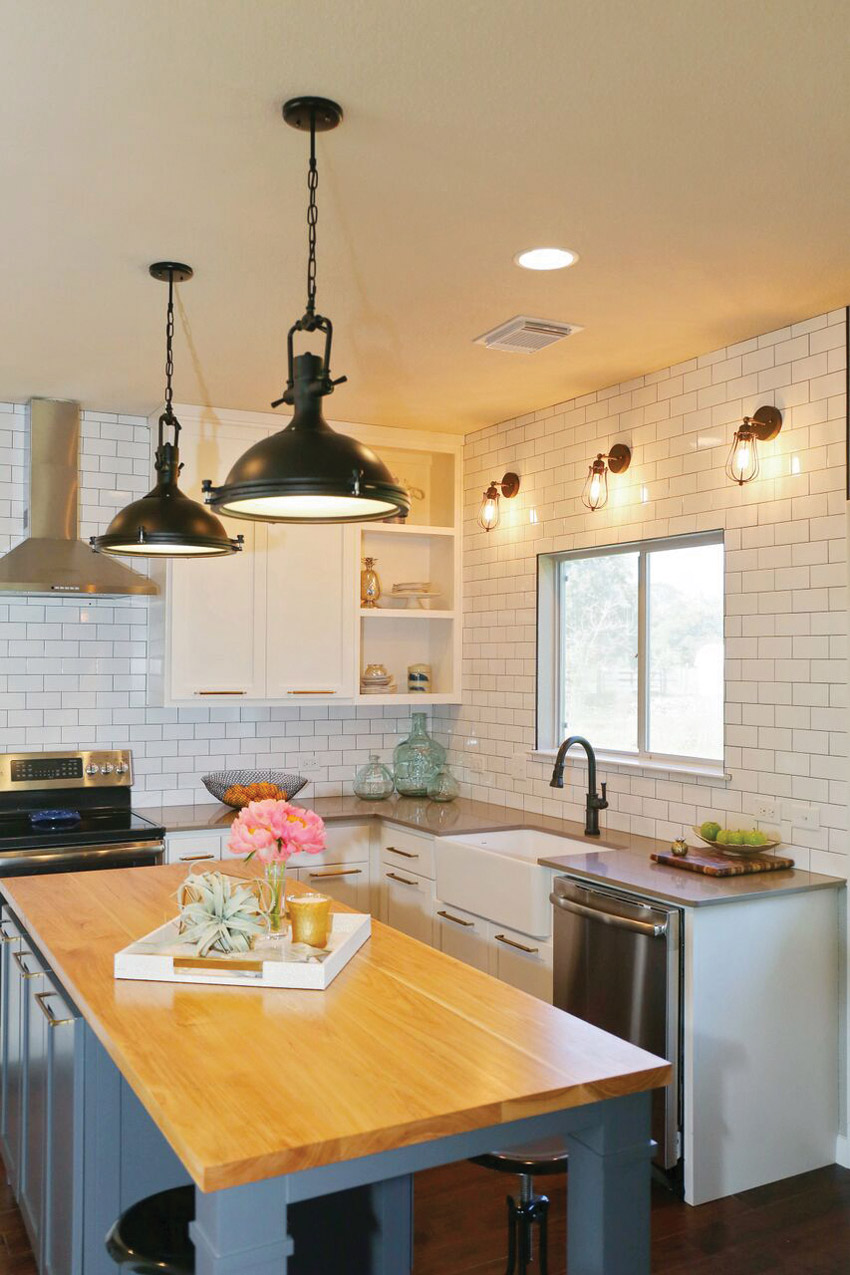
A private residence recently featured on HGTV’s House Hunters demonstrates a blended transitional aesthetic while also meeting the needs of a family that loves to cook.
The Marriage Between Art and Accessibility: ADA Compliance
The kitchen is a place for socializing with family and friends. Making changes in the kitchen space that accommodate both those with disabilities and the elderly can greatly increase its usability and safety. While the average home’s kitchen, including its kitchen sink, is not subject to codes, there are code requirements for residences serving people with disabilities. These ADA requirements are also gaining ground as benchmarks for aging in place design and in universal design.
Under ADA, there are five important requirements for accessible kitchen design:
- Clearance requirement: A 40-inch clear width is required in a pass-through kitchen; a 60-inch clear width is required in a U-shaped kitchen, as measured from the furthest projection points.
- Workspace: While countertops may be positioned as high as 36 inches above the finished floor, in order to allow for knee and toe clearance, a 30-inch-wide section of counter space, 28 inches to 34 inches above the finished floor and unobstructed by base cabinets, must be provided.
- Sink: An accessible sink is one located 28 inches to 34 inches above the finished floor, unobstructed for knee and toe clearance in a forward approach.
- Cabinets: Fifty percent of all shelf space within cabinets must be accessible, falling within one of the two reach ranges specified in ANSI section 308.
- Appliances: All appliances must have a clear floor space of 30 inches by 48 inches positioned for forward approach on the appliance. (For additional information on requirements, a helpful resource is Accessible Kitchen Design.)
Specific to kitchen sinks, under the ADA requirements, the sink should be 5 inches to 5 ½ inches deep to allow space for a wheelchair to go underneath and to not be so deep as to make it difficult for a seated person to reach to the bottom of the sink. This depth is derived from the ADA Maximum Counter surface height of 34 inches, an average counter thickness of 1½ inches, and the ADA Minimum distance between the floor and bottom of sink, set at 27 inches.

The accessibility requirements for kitchen sinks are calculated based upon a maximum height, counter thickness, and depth of kitchen sink from the floor.
Since a significant part of the work in a kitchen happens at the sink, having an ADA-compliant sink that is easy to use is also very important. Hands-free or lever-handled faucets with pullout sprayers can be considered for ease of use. These also may be best mounted to the side rather than at the back of the sink. Anti-scald devices may be added to prevent burns. The sink’s finish should be easy to maintain—radius corners should be smooth to the touch and easy to wipe clean. Smooth, nonporous surfaces ensure that dirt and bacteria can’t get inside, keeping the sink hygienic.
The architect and designer must proceed with caution when pursuing an ADA kitchen. While many individual products such as cabinet units and sinks may advertise ADA compliance, it is the kitchen as a whole—the sum of the parts—that will earn certification. The design of an accessible kitchen is one that involves all the elements in the space.
While not required under universal design or aging in place designs, ADA-compliant kitchens help ensure suitability and adaptability for a range of users over their lifetimes. Developed by Ronald L. Mace, AIA, universal design refers to design that works to ensure products and buildings can be used by virtually everyone, regardless of their level of ability or disability. Likewise, the movement to incorporate “aging in place” into design means to create the ability to live in one’s own home and community safely, independently, and comfortably, regardless of age, income, or ability level.
The heart of both these design movements, when applied to kitchen design, is about making life easier in the kitchen. Incorporating universal design themes into products in an aesthetically pleasing way is growing in importance. Manufacturers are increasingly looking at how to blend great functionality in an easy-to-care-for and easy-to-use design that delivers great style.
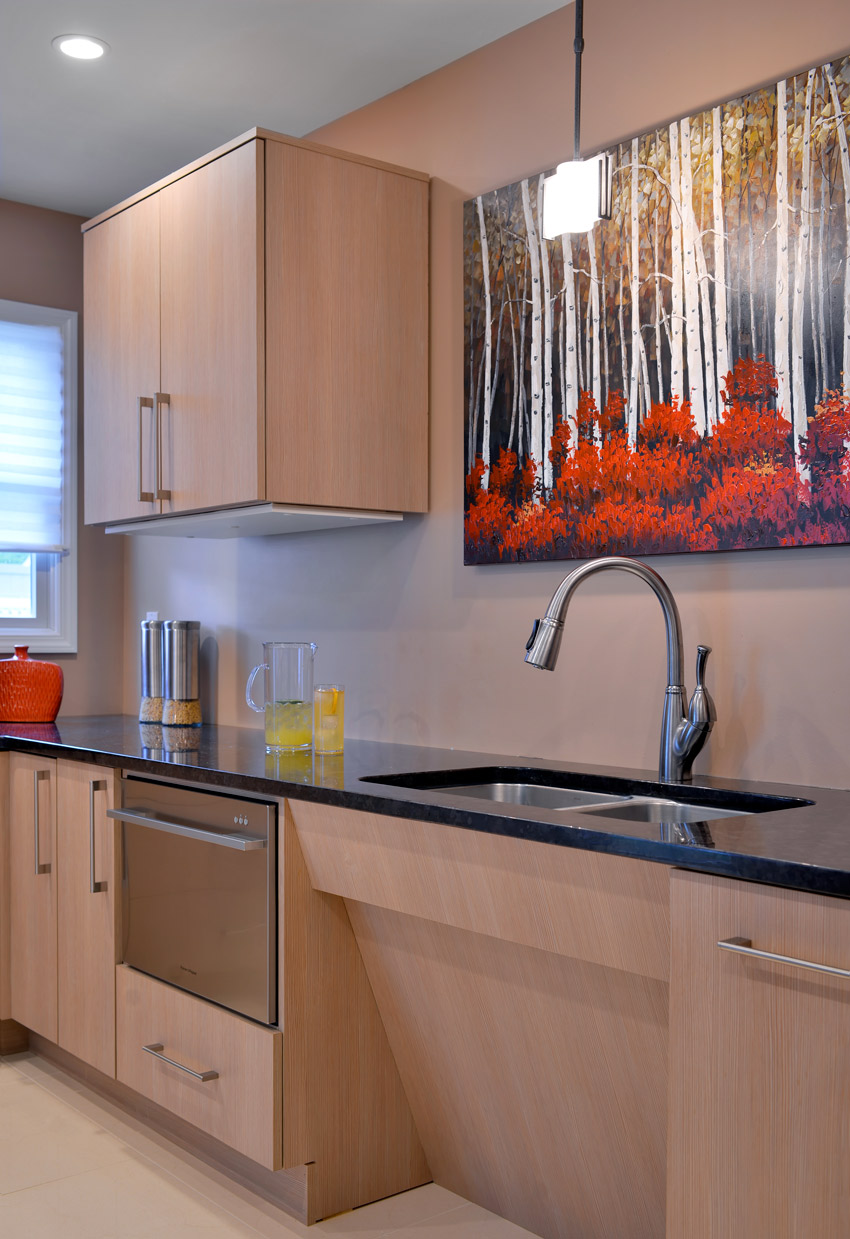
The accessible kitchen design featured in this private residence is both user friendly and aesthetically engaging.
Rising Trends in the Art
Colors and styles are all trending toward a contemporary aesthetic in today’s kitchen. Additionally, a transitional style in kitchens is emerging, blending both contemporary and traditional furniture and finishes into the design. Countertops and LED lighting are dominant product features; quartz is the most predominant material being used in kitchen countertops.
Sinks and faucets are also trending in the direction of transitional and modern looks. Smart, neutral colors, organic shapes, and clean lines are all taking hold. Peering into the future, designers and architects surveyed by a leading manufacturer responded that simpler designs and styles may be what’s next in the future of kitchen design. These simplified designs will favor fewer details and clean lines.
The living kitchen is driving many of these aesthetic trends as consumers are blending kitchen and furnished home areas into great rooms.
Color
When it comes to choosing a color for the kitchen, neutrals tend to win every time. With the average kitchen only remodeled every 15 years, highly stylized products and choices are eschewed to avoid dating the kitchen design. Greys and whites remain the most popular colors, and are projected to remain trending in kitchen designs for the future. However, some blues and soft pastels are appearing in palettes along the West Coast, particularly in California. Browns and creams also remain popular. The use of small areas of color as an accent within kitchen design is growing, and, once again, ties into the trend of personalizing a space. This aesthetic can range from using color on accent tiles to cabinets and even faucets.
Stainless steel remains a popular and in-demand product. However, designers are seeing an uptick in demand for neutral colors, like dual finishes for faucets and color-composite sinks. Stainless or satin nickel and polished chrome continue to be strong for faucets and hardware, especially for contemporary kitchens.
As composite materials for the kitchen escalate in popularity, consumers and designers will need to familiarize themselves with the marketplace and manufacturers’ proprietary blends. Not all materials are equal in touch or in durability, and not every material is nonporous and resistant to bacteria.
Technology
As smart technology continues its ascension in the home, so too will technology in kitchens continue to advance. While technology is not typically a term associated sinks and faucets, it highlights the groundbreaking ideas flourishing among manufacturers. More accessories are finding their way into the sink marketplace, adding functionality and saving space. Multifunctioning accessories such as built-in cutting boards and colanders can save space; a huge concern for homeowners. Today’s sinks may come with built-in cutting boards, colanders, and magnetic caddies for cleaning tools. They come in compact sizes and are custom fit to maximize sink use. Basin grids supplied by sink manufacturers help to maintain the bottom of the sink and keep dishes and other items from damaging the surface.
“What you are seeing in the market is a result of better production and product development technologies, which shortens the cycle of innovation,” explains BLANCO Product Manager Eric Gundersen. Technology is always improving, and the designs mature with it.
Materials
While stainless steel has had a long reign as the most popular material for kitchen sinks, a new survey of architects and designers reveals that stainless steel and granite composite are now head-to-head in popularity. As composite sinks that marry the benefits natural stone and durability have emerged, it has prompted manufacturers to introduce new stainless steel materials that are stronger, extremely resistant to scratches, and impervious to fingerprints.
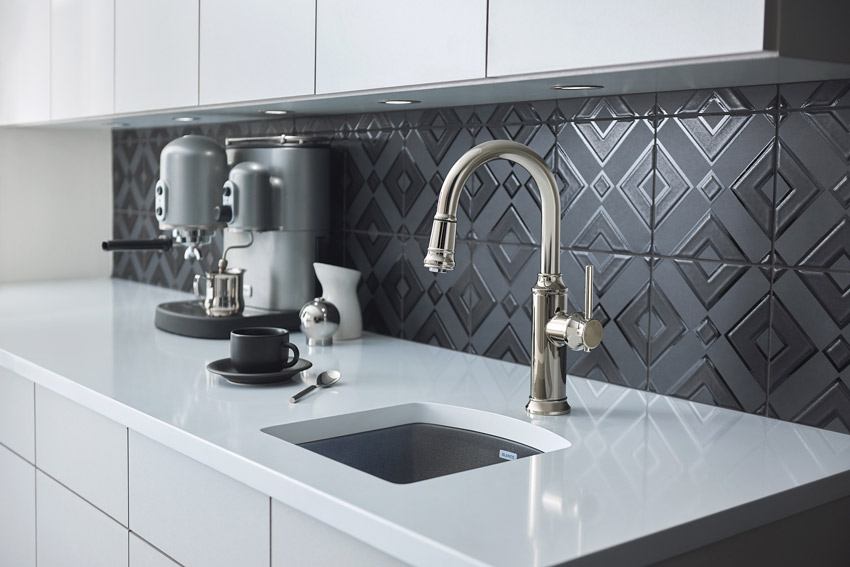
Recently, sinks sizes are trending away from standard options to embrace both smaller and larger profiles.
Sink Size and Design
Overall, sink size today shows a growing trend away from the limitations of standardized sink sizes, with designers and architects embracing both larger sizes and smaller, multiple sinks in a home. With the 2008 recession, many manufacturers’ lines compressed to the most popular SKUs for sizes. The market is now seeing growth both for smaller and larger sinks as new housing and remodeling rebound.
Single bowls continue to trend. Out of sink-bowl designs, single-bowl sinks are at 45 percent and are more popular than a double-bowl or a one-and-three-quarter bowl design. Single-basin sinks reflect an overall aesthetic trend toward simplification of lines, which also is mirrored by the popularity of undermount and flush-mount installations.
For sinks, apron-front, tight-radius, and rectangular single bowls are all trending right now. The general look is decidedly more design centric and modern—but also with a comfort or transitional feel. Not every sink or faucet is modern to the point of minimalist design. Rather, it is a general aesthetic edit that has gone through every collection, bringing with it cleaner lines, improved functionality, and enhanced performance, hygiene, and durability.
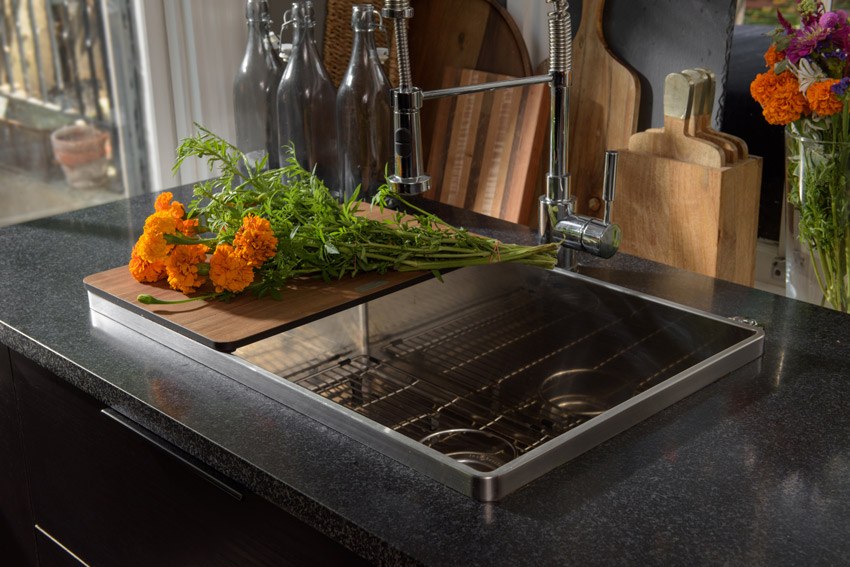
At the Miller Residence, built-in accessories help to maximize every inch of usable space in the sink and the kitchen itself.
The Challenge and Potential for the Art of the Sink
Today’s kitchen is not only the center for family, food, and entertainment, but it also is required to be stylish, aesthetically pleasing, functional, durable, and hygienic. Furthermore, it has to satisfy the needs of all its users and support a home’s overall design. Open floorplan schemes are at an all-time high, making living kitchens more prevalent in design room settings. The living kitchen is driving the shift toward contemporary, neutral, and organic lines, as consumers are blending kitchen and furnished home areas into great rooms. Homeowners with limited space want kitchens—and kitchen sinks—that look good and match the rest of the home’s aesthetic. The right combination of sink and faucet creates an ambience that matches any home living style.
Stylized mudrooms and laundry rooms also are bringing design out of the kitchen and into other areas of the home.
The designer helps to define what is important to their client in a kitchen. What can stay and what can go? By taking a lifestyle approach to a design project, the professional creates a space and selects products suitable for how clients cook, entertain, and live every day.
Paying attention to the unique combination of space, users will guide the selection of the best size, material, and style of kitchen sink. Ultimately, “things that are designed to be used always have an innate beauty.” —Julia Child
Amanda Voss, MPP, is an author, editor, and policy analyst writing for multiple publications. She also serves as the managing editor for Energy Design Update.

|
BLANCO has passionately elevated the standards for luxury sinks, faucets, and decorative accessories. Proud of its European heritage and award-winning German engineering, BLANCO has been committed to innovative design and unsurpassed service since 1925. Dedicated to uncompromising quality, every sink is closely inspected many times before it receives the BLANCO name. www.blancoamerica.com |
